Investigating the Ice-Induced Fatigue Damage of Offshore Structures by Field Observations
Abstract
:1. Introduction
2. Dynamics Analysis for Jacket Platforms
3. Fatigue Damage Assessment Method of Jacket Platforms
3.1. Calculation Procedure for Fatigue Analysis from Field Observation
- Set up a finite element model, and a mechanical model is established based on geometrical and physical properties of the structure, so as to ensure that the stiffness, total mass, and damping of the model are basically consistent with the field structure (in service).
- Make sure of the position of the hot spot stress of the platform.
- Set up an approximate mathematical relationship between the vibration response of the deck platform and the hot spot stress, considering environmental factors such as ice thickness, ice velocity, ice drifting direction, and action height of sea ice, and calculate the ice vibration response (displacement, velocity, acceleration) and hot spot stress of the structure based on the random ice force function. Using statistical method, a simplified mathematical relationship between the response of the structure and the fatigue hot spot stress in standard deviation is obtained.
- Fatigue damage assessment: the standard deviation and cyclic number of the structural response time history is obtained from field observation, the standard deviation of the structural fatigue stress are obtained according to the mathematical relationship established in step (3), and the fatigue damage of the structure in this observation period is analyzed with the Palmgren–Miner rule and S-N curves.
3.2. The Palmgren–Miner Rule
3.3. S-N Curves
4. Fatigue Damage Analysis by Field Monitoring
4.1. Find Position of the Hot Spot Stress
4.2. Set up the Mathematical Relationships
4.2.1. Ice-Induced Vibration Response Analysis
4.2.2. Analysis of Environmental Factors
4.3. Fatigue Damage Analysis of Platform
4.3.1. Decks Response of Field Observations
4.3.2. Results of Fatigue Damage and Discussion
5. Conclusions
- (1)
- There is an obvious linear relationship between the displacement response at the deck and the hot spot stress for standard deviation.
- (2)
- A series of numerical simulations are carried out for the various analysis cases considering the ice thickness, ice velocity, ice direction, and action height of sea ice. As a result, these factors do not have a significant effect on the linear relationship.
- (3)
- The fatigue damage results calculated with the proposed method are compared with the results obtained by the spectral analysis method. In this paper, the method has considered the real ice conditions and structural conditions. Therefore, it more accurately reflects extent of fatigue damage to the aging structure.
- (4)
- The discovery of the linear relationship can effectively avoid errors in numerical simulations, calculate the fatigue damage of the structure more quickly, and evaluate the safety performance of the structure. Furthermore, the research provides a basis for achieving the systematic management of sea ice.
Author Contributions
Funding
Institutional Review Board Statement
Informed Consent Statement
Data Availability Statement
Conflicts of Interest
References
- Wan, S.L. Assessment of Structural Safety and Design Optimization for Jacket Offshore Platform. Master’s Thesis, Dalian University of Technology, Dalian, China, 2019. [Google Scholar] [CrossRef]
- Zhang, D.Y.; Yue, Q.J.; Li, H.H.; Zhang, Y.J.; Xu, T. Structural safety ensuring system of offshore platforms in the ice zone based on full-scale measurement. In Proceedings of the China Mechanics Congress 2011 and the 100th Anniversary of Qian Xuesens’ Birth, Harbin, China, 22 August 2011. [Google Scholar]
- Zhang, D.Y. Performance Based Risk Design Research of Ice-Resistant Jacket Structures. Ph.D. Thesis, Dalian University of Technology, Dalian, China, 2007. [Google Scholar] [CrossRef]
- API RP 2N (E1988). Recommended Practice for Planning, Designing, and Constructing Fixed Offshore Structures in Ice Environments. Available online: https://www.api.org (accessed on 15 October 2022).
- Fang, H.C.; Xu, F.Y.; Chen, G.M. A New Method for Calculating Fatigue Life of Pipe Joints of Offshore Platforms in Ice Area. China Offshore Platf. 1997, 12, 259–264. [Google Scholar]
- Fang, H.C.; Xu, F.Y.; Chen, G.M. Fatigue Life Estimation of Pipe Joints of Offshore Fixed Platforms under Random Ice Loads. J. China Univ. Pet. 1997, 21, 50–54. [Google Scholar] [CrossRef]
- Braun, M.; Milakovic, A.S.; Ehlers, S.; Kahl, A.; Willems, T.; Seidel, M.; Fischer, C. Sub-Zero Temperature Fatigue Strength of Butt-Welded Normal and High-Strength Steel Joints for Ships and Offshore Structures in Arctic Regions. In Proceedings of the ASME2020 39th International Conference on Ocean, Offshore and Arctic Engineering, Fort Lauderdale, FL, USA, 28 June–3 July 2020. [Google Scholar] [CrossRef]
- Zhang, S.; Bridges, R.; Tong, J. Fatigue Design Assessment of Ship Structures Induced by Ice Loading—An introduction to the Ship Right FDA ICE Procedure. In Proceedings of the Twenty-first International Offshore and Polar Engineering Conference, International Society of Offshore and Polar Engineers, Maui, HI, USA, 19–24 June 2011. [Google Scholar]
- Liu, J.; Chen, G.M. Ice-induced fatigue analysis of offshore structures based on Määttanen model. J. China Univ. Pet. 2004, 28, 89–94. [Google Scholar] [CrossRef]
- Manttanen, M.P. Advances in ice mechanics in Finland. Appl. Mech. Res. 1987, 40, 1200–1207. [Google Scholar] [CrossRef]
- Blenkarn, K.A. Measurement and analysis of ice forces on Cook Inlet structures. In Proceedings of the Offshore Technology Conference, Houston, TX, USA, 22–24 April 1970; Volume 2, pp. 365–378. [Google Scholar] [CrossRef]
- Liu, Y.; Yue, Q.J.; Qu, Y.; Wang, R.X.; Yu, X.B. Estimation of ice-reduced fatigue life for ice-resistant jacket platforms. Ocean Eng. 2006, 24, 15–19. [Google Scholar] [CrossRef]
- Zhang, D.Y.; Liu, D.; Xu, N.; Yue, Q.J.; Guo, F.W. Fatigue life analysis of the vertical legs jacket platform induced by ice vibrations. Ocean Eng. 2015, 33, 35–44. [Google Scholar] [CrossRef]
- Suyuthi, A.; Leira, B.J.; Riska, K. Fatigue damage of ship hulls due to local ice-induced stresses. Appl. Ocean Res. 2013, 42, 87–104. [Google Scholar] [CrossRef]
- Jeong, H.K.; Yooil, K. Numerical Simulation on the Ice-induced Fatigue Damage of Ship structural Members in Broken Ice Fields. Mar Struct. 2019, 66, 83–105. [Google Scholar] [CrossRef]
- Jeong, H.K. Development of the Analysis Procedure for the Ice-Induced Fatigue Damage of a Ship in Broken Ice Fields. J. Offshore Mech Arct. 2020, 142, 061601. [Google Scholar] [CrossRef]
- Wei, C.; Leira, B.J.; Arvid, N. Short-term Extreme Ice Loads Prediction and Fatigue Damage Assessment for an Icebreaker. Ships Offshore Struct. 2018, 13, 127–137. [Google Scholar] [CrossRef]
- Høyland, K.V.; Nord, T.; Turner, J.; Hornnes, V.; Gedikli, E.D.; Bjerkås, M.; Hendrikse, H.; Hammer, T.; Ziemer, G.; Stange, T.; et al. Fatigue damage from dynamic ice action—The FATICE project. In Proceedings of the 26th International Conference on Port and Ocean Engineering under Arctic Conditions, Moscow, Russia, 14–18 June 2021. [Google Scholar]
- Yooil, K.; Jung, S.O.; Seock, H.J. Novel hot spot stress calculations for welded joints using 3D solid finite elements. Mar Struct. 2015, 44, 1–18. [Google Scholar] [CrossRef]
- Xu, H.; Chai, J.K. Numerical analysis of ice-induced vibration response of offshore platforms. Pet Eng. Constr. 2020, 46, 1–7. [Google Scholar] [CrossRef]
- Yooil, K. Estimation of the Fatigue Damage for an Ice-going Vessel under Broken Ice Condition Part I—Direct Approach. J. Soc. Nav. Archit. Korea 2019, 56, 217–230. [Google Scholar] [CrossRef]
- Yooil, K. Estimation of the Fatigue Damage for an Ice-going Vessel under Broken Ice Condition Part II—Simplified Approach. J. Soc. Nav. Archit. Korea 2019, 56, 231–241. [Google Scholar] [CrossRef]
- Wang, J.H. Research status and prospect of structural health monitoring standards at home and abroad. Constr. Saf. 2021, 36, 41–45. [Google Scholar] [CrossRef]
- Zhang, D.Y.; Yue, Q.J.; Che, X.F.; Liu, Y.; Li, H.H. Dynamic characteristics analysis of ice-resistant jacket platforms in Bohai Sea. Ocean Eng. 2010, 28, 18–24. [Google Scholar] [CrossRef]
- Li, G.; Zhang, D.Y.; Yue, Q.J.; Spurgeon, E.C. An efficient approximate algorithm for global reliability analysis of offshore platforms in ice regions. J. Dalian Univ. Technol. 2008, 48, 157–161. [Google Scholar] [CrossRef]
- Lee, G.; Lee, J.W. Estimation of Mode Participation Factor of Vibration Response Using Convolutional Neural Network Model. J. Korean Soc. Mech. Eng. 2021, 45, 1109–1116. [Google Scholar] [CrossRef]
- Vaibhav, S.; Jyoti, J.; Asim, T.; Sushil, M. Modified Rain flow Counting Algorithm for Fatigue Life Calculation. In Fatigue, Durability and Fracture Mechanics; Springer: Singapore, 2017; pp. 331–387. [Google Scholar] [CrossRef]
- SY/T 10030-2018. Recommended Practice for Planning Designing and Constructing Fixed Offshore Platform. 2018. Available online: https://std.samr.gov.cn/hb/search/stdHBDetailed?id=8B1827F2636DBB19E05397BE0A0AB44A (accessed on 18 October 2022).
- DNV (E2001). Recommended Practice DNV-RP-C203 Fatigue Strength Analysis of offshore Steel Structures. Available online: https://www.dnv.com/ (accessed on 20 October 2022).
- Thieken, K.; Achmus, M.; Lemke, K. A new static p-y approach for piles with arbitrary dimensions in sand. Geotechnik 2015, 38, 266–288. [Google Scholar] [CrossRef]
- Iversen, G.R.; Gergen, M. Regression analysis and correlation analysis of two numerical variables. In Statistics, 1st ed.; Springer Undergraduate Textbooks in Statistics; Springer: New York, NY, USA, 1997; pp. 396–471. [Google Scholar]
- Preumont, A.; Piefort, V. Predicting random high-cycle fatigue life with finite-elements. J. Vib. Acoust. Trans. ASME 1994, 116, 245–248. [Google Scholar] [CrossRef]
- Q/HSn 3005-2002; Fatigue strength analysis of offshore steel structures. China National Offshore Oil Corporation Enterprise Standard: Beijing, China.
- Mohammadi, S.F.; Galgoul, N.S.; Starossek, U.; Videiro, P.M. An efficient time domain fatigue analysis and its comparison to spectral fatigue assessment for an offshore jacket structure. Mar. Struct. 2016, 49, 97–115. [Google Scholar] [CrossRef]
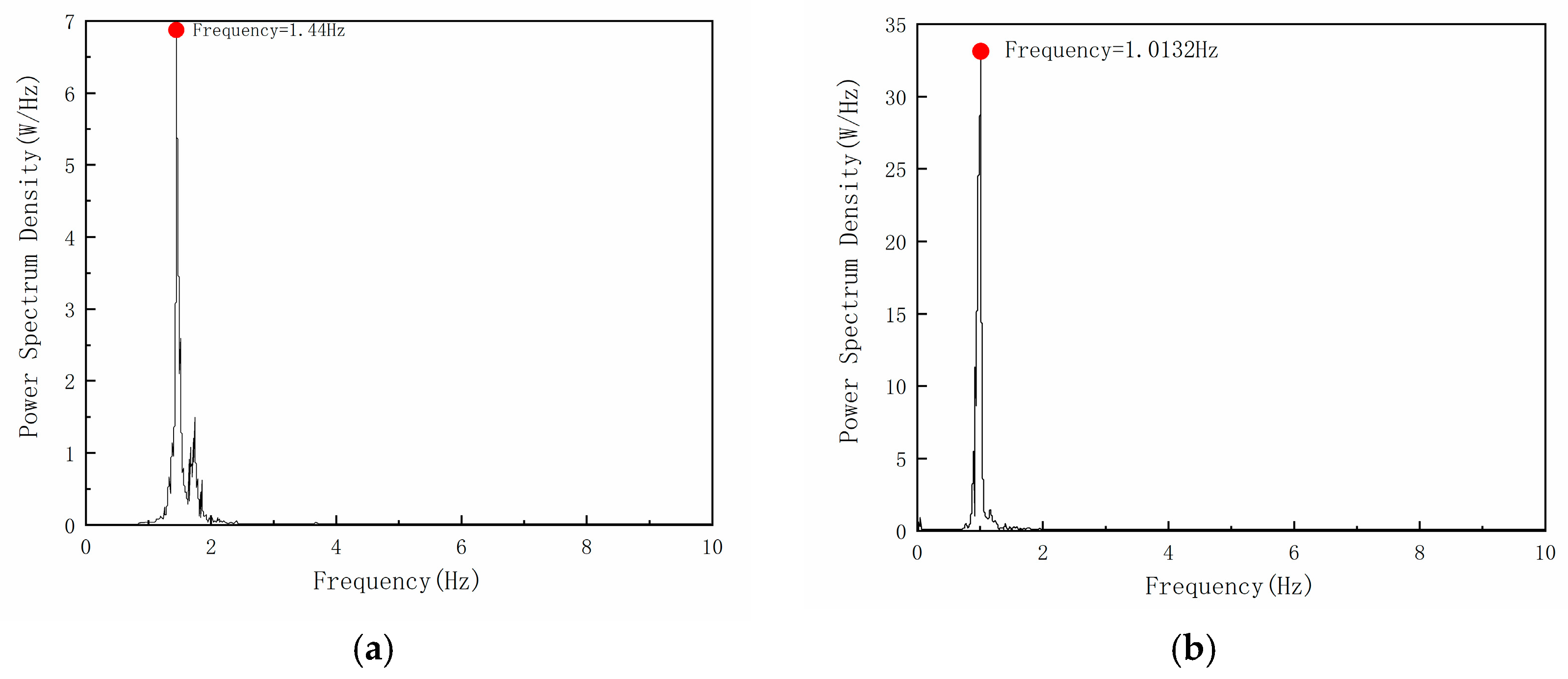
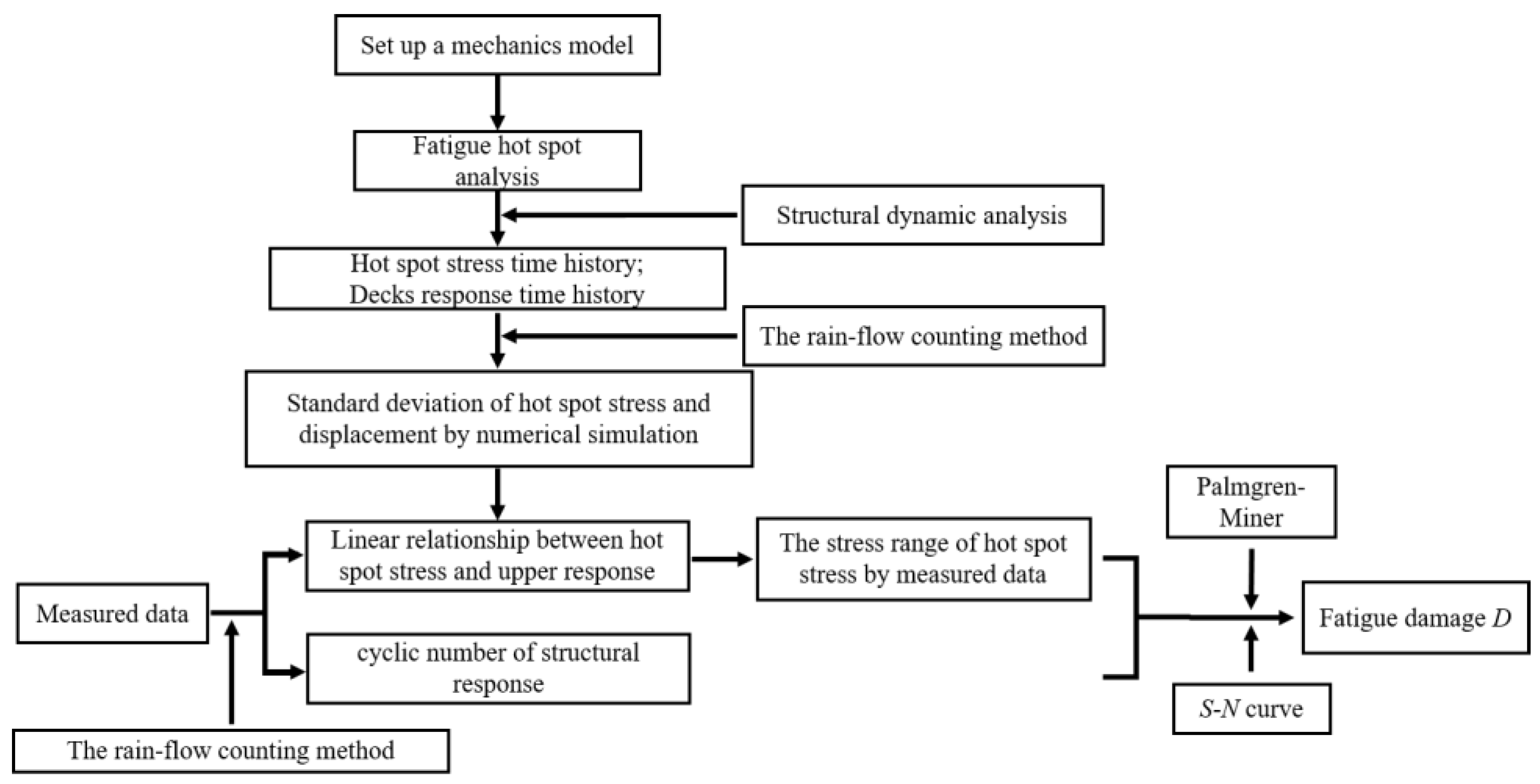

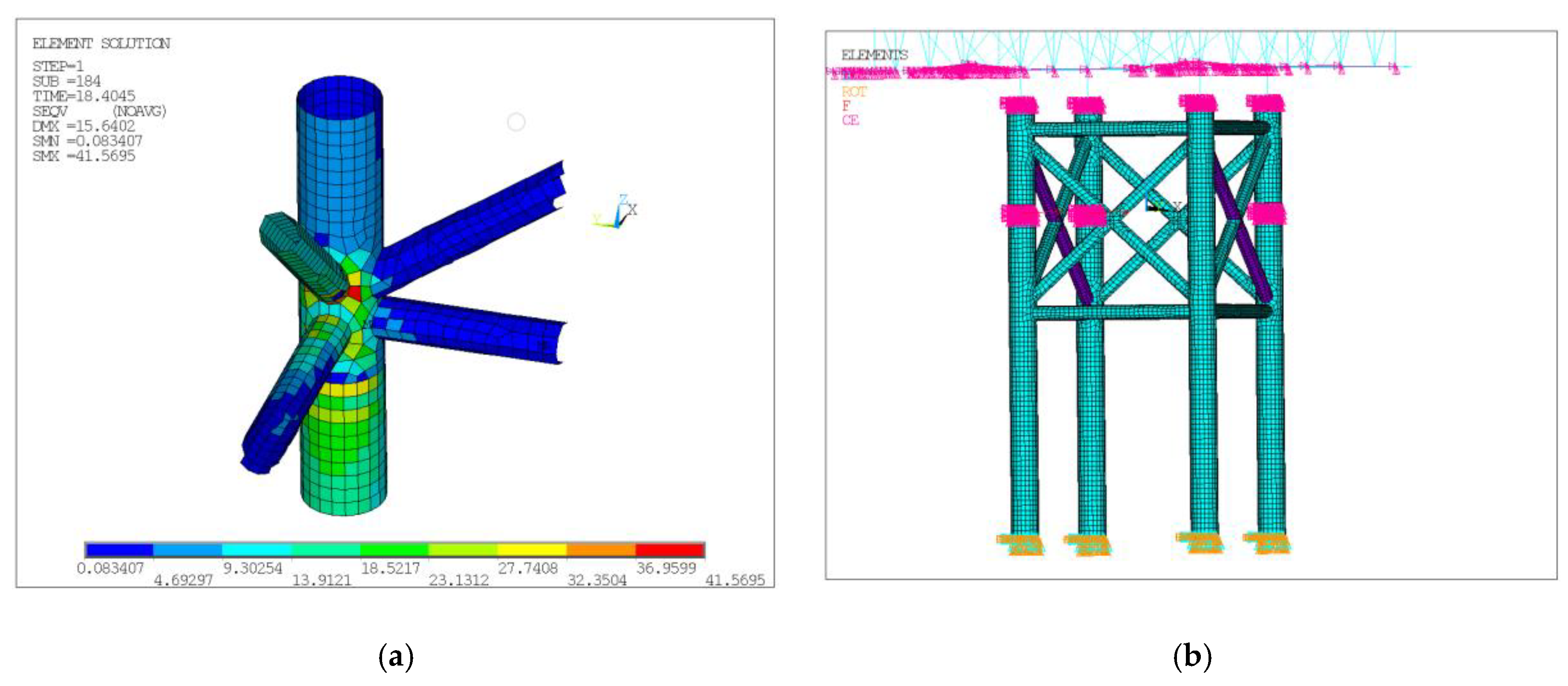
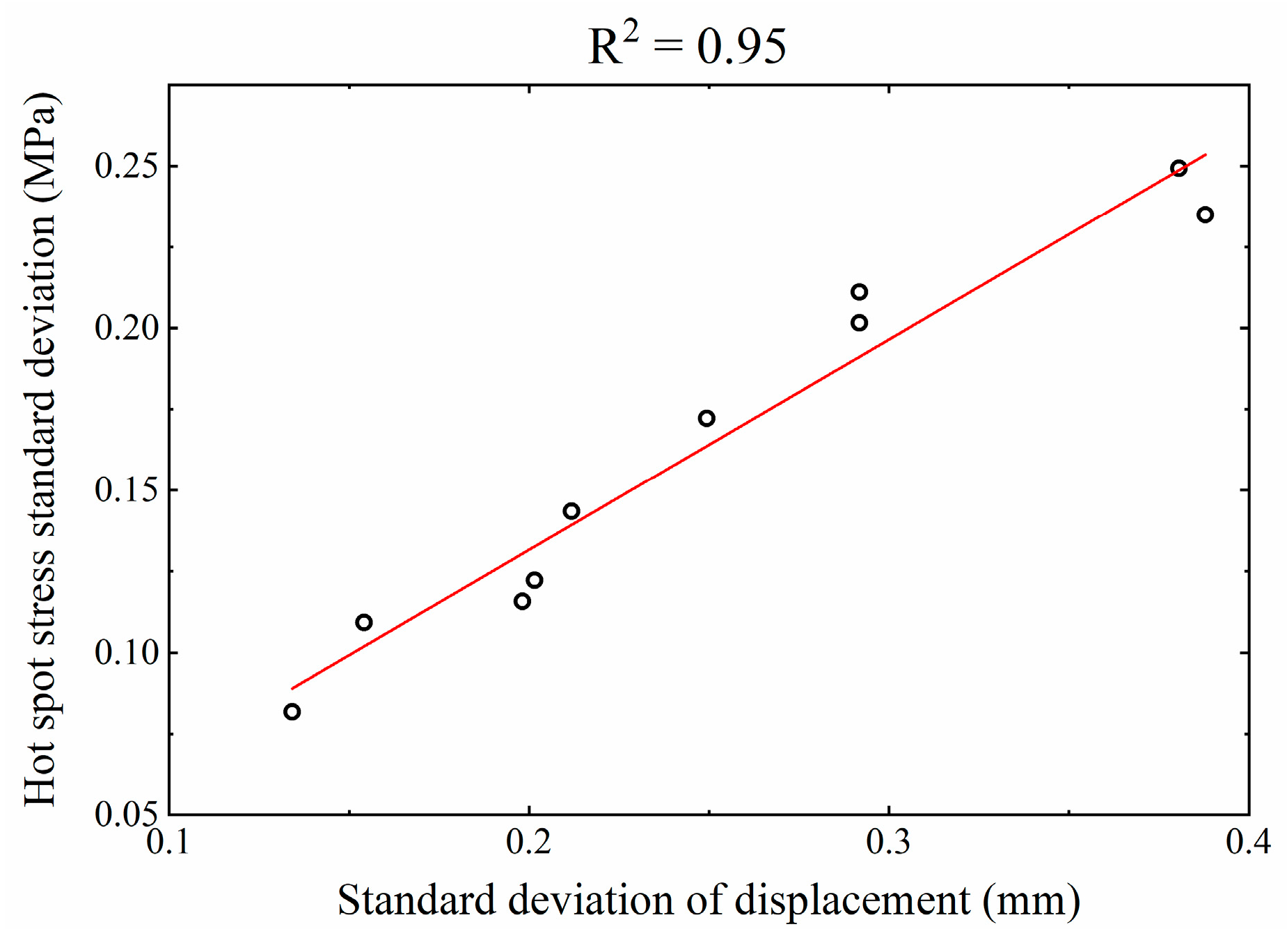

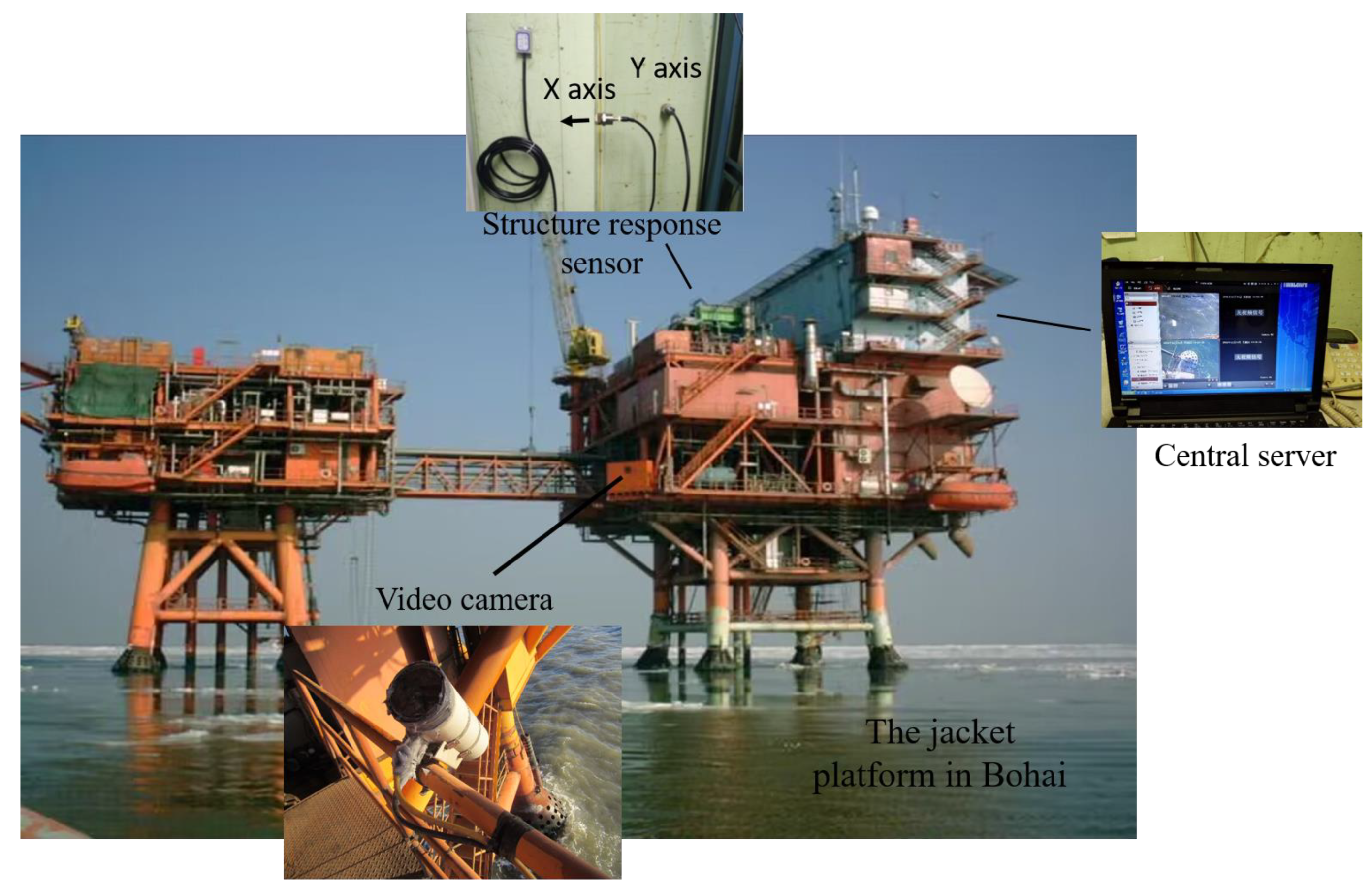
| Curves | (N/mm) | m |
|---|---|---|
| X | 100 | 4.38 |
| X’ | 79 | 4.74 |
| Mesh Sizes (m) | The Maximum Stress (MPa) | Percentage Change | Displacement Response (mm) | Percentage Change |
|---|---|---|---|---|
| 0.05 | 43.07 | 0% | 14.67 | 0% |
| 0.08 | 43.07 | 0% | 14.67 | 0% |
| 0.1 | 43.07 | 2.22% | 14.67 | 0.75% |
| 0.3 | 42.11 | 2.78% | 14.78 | 1.42% |
| 0.5 | 40.94 | - | 14.89 | - |
| Mode | The First | The Second | The Third |
|---|---|---|---|
| Frequency (Hz) | 1.11 | 1.18 | 1.22 |
| Time History Data Number | Stress Range (MPa) | Cyclic Number of Structural Vibration Response |
|---|---|---|
| 1 | 128.3 | 471 |
| 2 | 90.66 | 472 |
| 3 | 145.36 | 827 |
| 4 | 49.5 | 806 |
| 5 | 62.96 | 1001 |
| Time History Data Number | Method Proposed in this Article Fatigue Damage | Spectral Analysis Fatigue Damage |
|---|---|---|
| 1 | 7.02 × 10−4 | 1.60 × 10−6 |
| 2 | 1.54 × 10−4 | |
| 3 | 2.12 × 10−3 | |
| 4 | 1.85 × 10−5 | |
| 5 | 6.59 × 10−5 |
Disclaimer/Publisher’s Note: The statements, opinions and data contained in all publications are solely those of the individual author(s) and contributor(s) and not of MDPI and/or the editor(s). MDPI and/or the editor(s) disclaim responsibility for any injury to people or property resulting from any ideas, methods, instructions or products referred to in the content. |
© 2023 by the authors. Licensee MDPI, Basel, Switzerland. This article is an open access article distributed under the terms and conditions of the Creative Commons Attribution (CC BY) license (https://creativecommons.org/licenses/by/4.0/).
Share and Cite
Huang, Y.; Yu, S.; An, T.; Wang, G.; Zhang, D. Investigating the Ice-Induced Fatigue Damage of Offshore Structures by Field Observations. J. Mar. Sci. Eng. 2023, 11, 1844. https://doi.org/10.3390/jmse11101844
Huang Y, Yu S, An T, Wang G, Zhang D. Investigating the Ice-Induced Fatigue Damage of Offshore Structures by Field Observations. Journal of Marine Science and Engineering. 2023; 11(10):1844. https://doi.org/10.3390/jmse11101844
Chicago/Turabian StyleHuang, Yating, Songsong Yu, Tai An, Guojun Wang, and Dayong Zhang. 2023. "Investigating the Ice-Induced Fatigue Damage of Offshore Structures by Field Observations" Journal of Marine Science and Engineering 11, no. 10: 1844. https://doi.org/10.3390/jmse11101844
APA StyleHuang, Y., Yu, S., An, T., Wang, G., & Zhang, D. (2023). Investigating the Ice-Induced Fatigue Damage of Offshore Structures by Field Observations. Journal of Marine Science and Engineering, 11(10), 1844. https://doi.org/10.3390/jmse11101844






